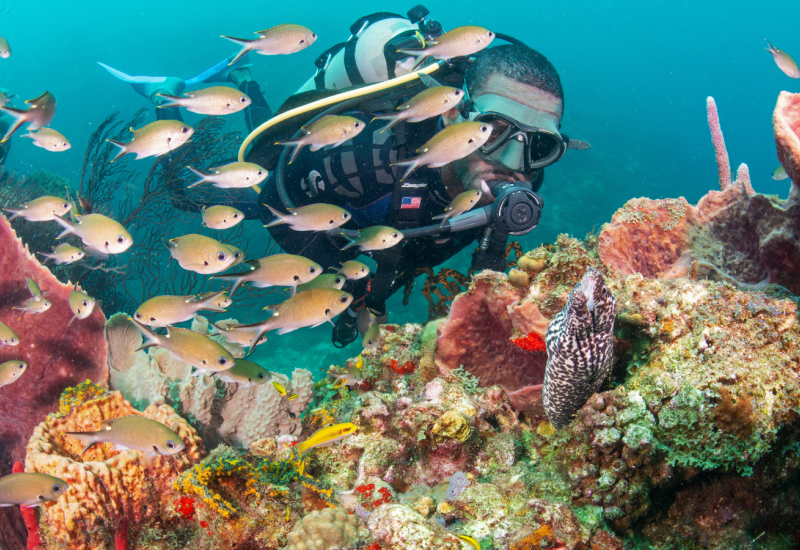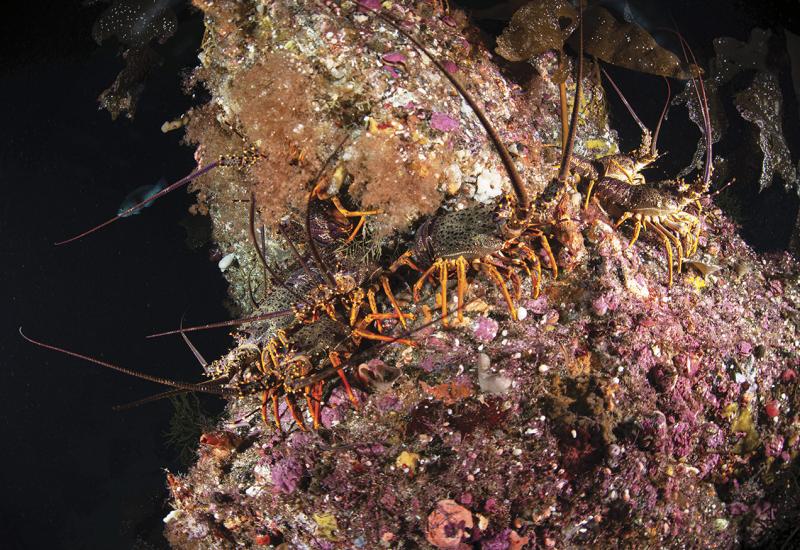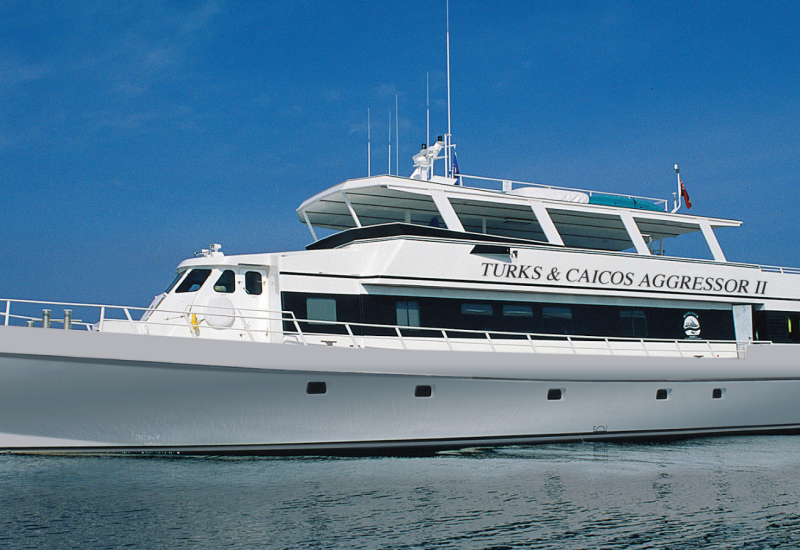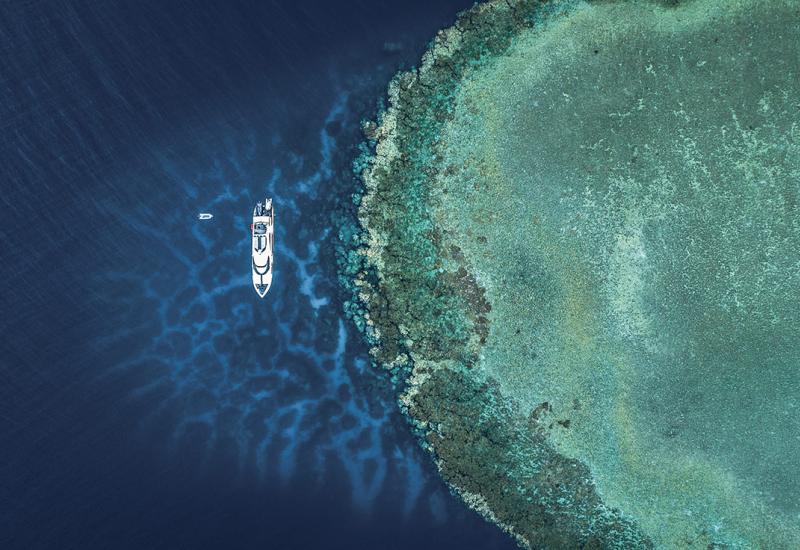How to Dive Lobos Rocks in Monterey Bay

Clinton BauderHordes of sea lions and sheer walls covered in colorful invertebrates are some of the underwater surprises at this Monterey Bay National Marine Sanctuary dive site.
"It’s one of the most magical sites that I’ve experienced in Monterey.” So says local diver Dane Durand about Lobos Rocks, a standout among the Monterey area’s stellar dive sites despite its relative inaccessibility.
A couple of hours via boat from Monterey Harbor, this pair of rocks jutting out high above the ocean holds the respect of the area’s dive community. The offshore site lies in the Monterey Bay National Marine Sanctuary, on the opposite side of the Monterey Peninsula from gentler sites such as San Carlos Beach and Breakwater Cove.
The allure of Lobos Rocks has held fast thanks to its remote and rugged location— the eye-catching topography typically sets up challenges to access, and the weather has to be just right for boats to make the trip. It’s not for the faint of heart, but Lobos Rocks rewards divers with its vivacious sea lion population, underwater flora and fauna, and proximity to other reefs.

Patrick WebsterTopside view of Monterey Bay National Marine Sanctuary with Lobos Rocks seen in the distance.
Durand, who is general manager of Aquarius Dive Shop in Monterey, loves the challenge of Lobos Rocks. Beyond instructing and diving all around the Monterey area over the past 12 years, Durand has most enjoyed working on underwater productions featuring the two “super massive pinnacles” at Lobos Rocks with National Geographic and other media organizations to highlight the unique environment and its marine life.

Robert LeeLobos Rocks vibrantly colored by invertebrates, with sea lions playing above.
“One of the best things, and the reason for going out there with BBC, were the sea lions. We saw upward of 200 sea lions once we dropped anchor,” Durand recalls. “It was the most concentrated, clear water I’ve ever seen with sea lions in my entire life.”
Phil Sammet, owner of the charter and dive operator Underwater Company, first dived Lobos Rocks in 1987 after he moved to Monterey. He estimates that during the end of the summer season, there might be one day out of every two months when conditions are conducive to diving there—not unlike finding a diamond in the rough. “It’s out in the open ocean,” Sammet explains. “You have two rocks that stick out of the water, 60 feet high, with 50 feet of water between. Both rocks have little sisters that stick 5 feet out of the water and go down about 115 feet.”
On a good day, divers can find large anemones and metridium on the walls, and red gorgonian fans on the floor near the little sisters, Sammet says. A channel spans the rocks from east to west. The east and west sides of the seamount dip down to about 100 feet and offer divers an opportunity to explore further.
Related Reading: Where to Scuba Dive in Northern California
Durand says one of the things that appeals to local divers is that it’s not necessary to go beyond recreational limits given the average depths of about 45 feet when circumnavigating the seamount. However, Sammet and Durand caution that water entry in the gap between the rocks can be more difficult due to the swells.
Anchoring on the south side of the seamount can be a little smoother, and venturing a little farther south of the rocks, divers in search of a more mellow dive can find a shallow reef that Sammet likes to visit. He says the visibility out at Lobos Rocks is usually double the length of the viz in Monterey Bay proper. Because it’s offshore and westerly facing, there’s “much clearer water that’s not cloudy from being sucked into the bay in Monterey,” adds Durand.
Fewer divers from the Monterey community are making the trek out to Lobos Rocks nowadays. The area is about 20 nautical miles from the harbor, and thus requires thorough preparation and briefings. Durand packs plenty of provisions, oxygen, medical kits, and spares or backups of every piece of equipment. For comfort amid the open-ocean temperatures, he prefers to wear a drysuit.
For those fortunate to experience it, the most significant benefit of the remote location means you might have the place to yourself.
SITE SPOTLIGHT

Illustration by Cassidy VincentVermilion rockfish are a bright presence near Lobos Rocks.
Vermilion rockfish (Sebastes miniatus) are a bright presence near Lobos Rocks and the surrounding area. Their mottled red-orange fins can be spotted along most of the California coast, where they live in (you guessed it!) rocks at depths of about 100 feet, although younger vermilion rockfish are found at shallower depths.
This spiny marine creature can grow over 2 feet long and weigh up to 14 pounds. According to the California Department of Fish and Wildlife, they are part of the shelf rockfish category, which are typically found in depths near the continental shelf. The vermilion rockfish is especially vibrant among the dozens of rockfish species found along the coast.
NEED TO KNOW
Conditions
Viz varies, but when the viz in Monterey Bay is 10 feet, you can expect it to be about 20 feet out at Lobos Rocks. Water temps range from the mid- to low 50s—about the same as those seen in Monterey Bay. The area is affected by swell surges. Interesting upwellings and downwellings happen with Monterey Canyon, Durand says.
When to Visit
For the best days with mild swells, dive Lobos Rocks toward the end of summer or in early fall.
How to Dive It
Hire a private boat. As with any dive, preparation is key—make sure you have enough fuel and supplies stocked for a remote dive in swells.
What to Wear
Drysuit or 7 mm wetsuit.
Local PADI Dive Shop
Aquarius Dive Shop Monterey, California aquariusdivers.com










